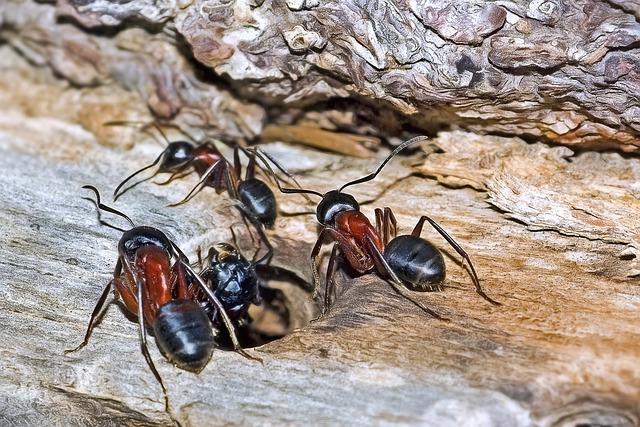Ants come in a multitude of species, sizes, and habitats. Among these diverse creatures, some species stand out for their impressive size.
In the bustling metropolis of New York and across the vast expanse of the United States, various ant species claim the title of being among the largest. From the extensive landscapes of the US to the far reaches of the globe, these colossal ants not only intrigue us but also play vital roles in their respective ecosystems.
Understanding the distinction between these giants and their smaller counterparts unveils a realm of unique adaptations, intricate social structures, and behaviors that set them apart.
Throughout this guide, we’ll delve into the notable species of large ants found in New York and the United States and the largest ants known worldwide.
The Giants of New York: Notable Species of Large Ants
In New York, several species of ants claim to be among the largest. One such prominent species is the Carpenter Ant (Camponotus spp.), known for its size and robust appearance.
While they don’t rival some of the largest ant species globally, the Carpenter Ants found in New York can grow to impressive sizes compared to other local ant species. These ants play a crucial ecological role by aiding in decomposition and serving as scavengers, contributing to the balance of their respective habitats.
Another notable mention among the sizable ants in New York is the Allegheny Mound Ant (Formica exsectoides). Though not among the largest globally, these ants create extensive colonies with large mound-like nests, displaying intricate social behaviors and interactions within their communities. Their conspicuous mounds are distinctive across certain landscapes in New York and neighboring regions.
Beyond New York, the United States hosts several other large ant species that command attention for their size and behaviors. Among these is the Florida Carpenter Ant (Camponotus floridanus) in the southeastern states. These ants are noteworthy for their large size and impressive colonies, featuring intricate tunnels within wooden structures.
The Western Harvester Ant (Pogonomyrmex occidentalis) is another formidable contender among the large ant species in the southwestern United States. These ants construct vast underground colonies and possess strong mandibles, displaying aggressive behaviors when their nests are disturbed.
Beyond Borders: Exploring the Biggest Ants Worldwide
Venturing across the globe unveils a diverse array of impressive ant species renowned for their sheer size and distinctive characteristics.
One of the globally recognized giants in the ant world is the Giant Forest Ant (Camponotus gigas), which is found in various parts of Southeast Asia. These formidable ants can measure up to an inch in length, making them among the largest globally. Often constructed in rotting wood or forest floors, their nests house massive colonies exhibiting complex social structures.
Another colossal contender is the Dinoponera gigantea, commonly known as the Giant Amazonian Ant. Residing in the rainforests of South America, these ants can reach sizes exceeding an inch, displaying powerful mandibles and a fearsome appearance. Their predatory nature and large colonies distinguish them as notable inhabitants of the Amazonian ecosystems.
Moving to Africa, the Driver Ants (Dorylus spp.) claim their place among the largest and most intriguing ants. These ants, known for their nomadic lifestyle and immense colonies, exhibit “swarming,” where they travel en masse searching for food, clearing their path of other organisms. This behavior has earned them the nickname “army ants.”
In Australia, the Bulldog Ants (Myrmecia spp.) reign as some of the largest ant species found on the continent. Their size, potent venom, and aggressive behavior make them formidable predators within their habitats.
These diverse species of ants found across continents showcase the fascinating adaptations and roles they play within their ecosystems. From the dense rainforests of South America to the savannas of Africa and beyond, these colossal ants command attention for their size, behaviors, and ecological significance.
Understanding Adaptations of the Largest Ants
The colossal size of the largest ant species isn’t their only remarkable feature; these insects possess many adaptations that contribute to their ecological success.
- Colony Complexity: Like ants of other species, most of these species often form extensive societies with intricate hierarchies, comprising multiple castes fulfilling specialized roles. The division of labor within these colonies allows for efficient organization and resource management.
- Mandibles and Defensive Mechanisms: The formidable size of these ants often correlates with powerful mandibles. These mandibles serve various purposes, from hunting and foraging to defense against predators. Some species possess venomous stings or sprays as additional defensive mechanisms, enhancing their ability to protect the colony.
- Foraging and Feeding Strategies: These ants exhibit diverse foraging strategies. Some species are adept scavengers, while others are efficient predators, hunting small invertebrates or even larger prey. Their ability to gather food and sustain their colonies contributes to their success in diverse habitats.
- Environmental Adaptations: Some of the largest ants have evolved to thrive in various environments, displaying adaptations to withstand diverse climatic conditions. Some species can endure extreme temperatures, while others have specific adaptations to survive in humid, tropical rainforests.
Eliminate Ants with United States Pest Services!
Whether you’re dealing with the large and in-charge carpenter ants or tiny sugar ants, we have your back. We’re proud to offer comprehensive ant control services to the residents of Rockland and Middletown counties in New York.

